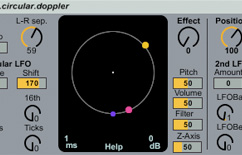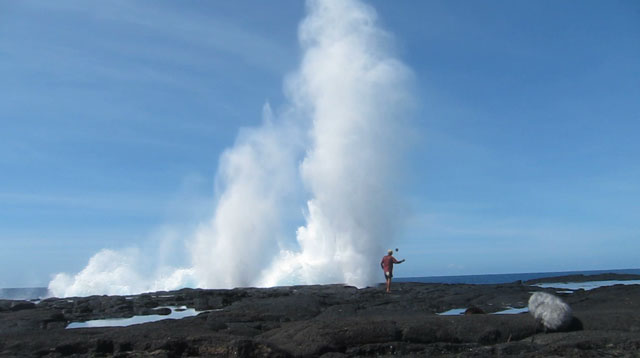Welcome to SFX Lab, the “laboratory” of sound effects, a place dedicated to experiment and explore sound libraries with the goal of learning different kinds of sounds and some of its morphing features.
We take libraries of a certain theme and put them through some experiments. Think about not only what you will learn, but also for what your ears are obtaining. Some time ago, I read an inspiring interview of Walter Murch, where he said:
“Never before in history, before the invention of recorded sound, had people possessed the ability to manipulate sound the way they’d manipulated color or shapes. We were limited to manipulating sound in music, which is a highly abstract medium. But with recorded material you can manipulate sound effects—the sound of the world—to great effect. In the same way that painting, or looking at paintings, makes you see the world in a different way, listening to interestingly arranged sounds makes you hear differently.”
So, that’s the goal of this. To never stop hearing new sounds and researching them in depth. Exploring from these thematic libraries is a great way to train ourselves and teach us a lots of new things about the sounds we use, the many things we can find in a single collection of sounds and what we can derivate from them, etc. If you don’t learn anything from the text, just think about this section as an art gallery in the street. You can go there to hear see the pieces and allow your mind to explore.
HISS and a ROAR Pressure
One thing I love from these kind of sfx packages is that you never stop exploring the content. Think about this as not only a variety of material for fabricating new designs but also about how much you can explore such a complete palette of sounds and learn what these objects can do.

The variation of performances, perspectives, tools, gear and processes are really valuable things that teach you a lot about real life sounds, and of course when it comes to design, what you have is a lot of control and more accurate sources.
[soundcloud url=”http://api.soundcloud.com/tracks/7225980″]
Pressure is a perfect example of this. Just imagine that you need to find 50 different ways of demonstrating pressure with sound and record all these variations. Then, you end up with a wide palette of pressure sounds that will teach you a lot of things they can do. The list in this case includes interesting triggers, shots in resonant tubes, paintball guns, air compressors, trains and a wide variety of amazing air release sound effects.
Air Release Experiments
As almost any sound, this material can be turned into a lot of different things. However, here are some things I’ve done with the sounds of the library that demonstrates some of its potential. Just some ideas and examples.

Cutting the Air
Any kind of long air/hiss release sound can be very cool for making whooshes, swishes, and those kind of sound design elements. The recordings included, feature sounds with several tonalities and movements, which means variety in the results as well.
[youtube]http://www.youtube.com/watch?v=T7boDTnQ-FQ[/youtube]

You can get instant pitch-amplitude variations using a doppler plugin like GRM Tools Doppler or Waves Doppler. There’s also another cool doppler for Max for Live and made by Robert Henke. It’s also good to use automated/modulated filters to cut frequencies over time, create some cool filter sweeps, etc.
Also, a multi-effect or some crazy effect that allows to change pitch is also very cool for shaping your whooshes. Some examples would be GRM PitchAccum, SoundToys Crystalizer or Audio Damage Discord.
Some Blasts
These kind of triggers, gun shots and fast attack sounds are wonderful material for weapon sound design, mechanical stuff, etc. I’ve recently used these kind of sounds for making some interesting layers for some alien weapons. Some layer blasts below:
[soundcloud url=”http://api.soundcloud.com/tracks/14008104″]
Can’t remember exactly how was the processing on those sounds. I first make a chain on Soundminer using GRM Reson and SoundToys PhaseMistress on several of the paintball gun shots. Then it was just about experimenting with PhaseMistress modulation and frequency.
From that process, I got several sources with variety of tonality, resonance, etc. Then I processed that palette again, obtaining sounds like those blasts you just listened. Many of the effects obtained are just by performance, since I like to ReWire Pro Tools and Soundminer and tweak parameters in real time; but also some modulation was present, both on pitch and frequency. Keep in mind that my goal this time was to get cool and unexpected weird blast layers, so I just experimented and combined different values and processes, without caring where I was going.
As IRs
Many of the sounds included in this library, and particularly sounds with fast attacks and natural decay are great for using as IRs in a convolution reverb such as Altiverb or other convolution processors. For example, in the library you can find some recordings of a paintball gun being shot though a pipe, so the gunshots are recorded with a natural resonance which makes a cool “ringing” reverb in Altiverb.
The process is pretty simple. You place stereo split files (L and R separate) of the sound in your Altiverb Impulse Response folder. In my case:
![]()
You can also add images in that folder and Altiverb will link them automatically to that IR. So, with the paintball gun shot, it looks like this:

Finally let’s hear an example of the reverb obtained. Here’s a recording of a big creaking door I captured some time ago. I processed it with the reverb (using the paintball gun IR I just created) and did some pitch variations.
[soundcloud url=”http://api.soundcloud.com/tracks/14008074″]
Experiments on Nature: HISS and a ROAR Blow Holes
Blow Holes is another library loaded with really fantastic recordings. It’s loaded with sounds captured by Tim Prebble at four different locations chosen especially for their sonic characteristics.

The recordings are so alive and unique. Its a pleasure for the mind to just think about those fantastic places where the sounds were recorded. There are some long recordings with soft nice waves hitting the rocks, but there are also aggressive water releases with a wide variety of perspectives and tonalities.
The library is very dynamic, allowing to obtain really detailed and diverse ambiences, but also a lot of interesting sounds if you process them in some ways, such as a short and simple rumble layer, obtained just with EQ and pitch shifting:
[soundcloud url=”http://api.soundcloud.com/tracks/14008101″]
Or a long one, more earthquake alike:
[soundcloud url=”http://api.soundcloud.com/tracks/14008099″]
drones, perhaps? (obtained with the hits of the waves on the rocks)
[soundcloud url=”http://api.soundcloud.com/tracks/14008085″]
dark?
[soundcloud url=”http://api.soundcloud.com/tracks/14008076″]
bright?
[soundcloud url=”http://api.soundcloud.com/tracks/14008082″]
Torture Chamber
On each article of this series I’ll also include a video where I start to play the sounds of each library with an specific tool. The goal is to just tweak anything and hear what sounds start to appear.
In this case I’ve processed the sounds of Pressure with Scapes, a powerful multi-effects created by Twisted Tools. It runs on Reaktor, combining lots of effects and processing types (delays, reverb, granular synthesis, various of filters, etc) with crazy modulation and sound generation. It’s really cool for making crazy noises.
[youtube]http://www.youtube.com/watch?v=F_cd27YewUA[/youtube]
Blow Holes was also tortured, this time with one of the new plugins included in the GRM Tools collection, called GRM Evolution, used to obtain continuous evolution of timbre, by frequential sampling of the input signal. In this case the process was done using Evolution as standalone, but it also works as plugin.
[youtube]http://www.youtube.com/watch?v=sY2KNDNGjlo[/youtube]
Links: Scapes | GRM Tools | HISS and a ROAR
Learn more about GRM Plugins in this fantastic article by Jamie.
That’s all, folks!
[Feel free to share any tip or trick you have for designing sounds from air sources or pressure release sounds. I’ll add your tips to the post, so you could browse the stuff in the future and learn]
Great post Miguel! Experimentation is a lot if fun ;) will hope to check out some demos of GRM Tools if I get time over the weekend. They look pretty cool!
Cool stuff, definitely keep this series up. The videos of your experimentation plus the tie-ins to the independent libraries we’re already reading about are a nice combination.
Great stuff:)
Awesome post Miguel! Thanks a lot
Thanks!! :D